Did you know that out of the countless varieties of orchids cultivated worldwide, there is a group that is adored not for their blossoms but for their intricately patterned leaves?
Welcome, fellow enthusiasts of indoor gardening, to the compelling world of the Jewel Orchid, a family that includes some particularly rare and striking species.
While I continually immerse myself in the search for new plant care tips, I am particularly enchanted by these terrestrial beauties.
Often overshadowed by their showy-flowered relatives, Jewel Orchids, with their lush, mosaic-like foliage, are uncharted treasures awaiting cultivation in your living spaces.
Learning to provide the right jewel orchid care is akin to uncovering a rare gem within the flora kingdom. Unlike their high-maintenance counterparts, these low-light lovers promise to elevate your home’s aesthetics with minimal fuss.
My passion for unique plant varieties naturally drew me towards these rare jewel orchid varieties, and I’m thrilled to share with you a comprehensive guide that illuminates every aspect of nurturing these ornamental masterpieces.
Key Takeaways
- Unlock the secrets to growing rare jewel orchid varieties with dedicated indoor gardening techniques.
- Jewel orchids stand out for their foliage, demanding a unique approach to plant care.
- My firsthand experience offers practical plant care tips tailored to the needs of these special orchids.
- Thriving jewel orchids can transform any space, proving the reward of meticulous care.
- Explore the distinctiveness of terrestrial orchids and how they differ from typical epiphytic orchids in care.
- Learn the art of ensuring your jewel orchids are as healthy as they are aesthetically pleasing.
Understanding Your Jewel Orchid
As your guide through the enchanting world of jewel orchid varieties, I’m thrilled to introduce you to the marvels of Ludisia discolor.
This terrestrial treasure is dear to my heart, not only for its breathtaking leaves but also for its remarkable resilience as an indoor companion.
The Basics of Ludisia Discolor
Recognized for its stunning foliage, Ludisia discolor, or the Jewel Orchid stands out among terrestrial orchids.
They claim a special place in my indoor garden, thriving in conditions that mimic the lush understory of their native habitats.
Their low-light resilience and ease of care make them unique from their sun-hungry relatives.
The tapestry of colors on their leaves mesmerizes me every time I catch a glimpse, each one a piece of living art.
The indulgent maroon backdrop, overlaid with pinstripes of pink and white, makes this species a central piece in my collection of indoor orchid care subjects.
Origins and Distribution
My beloved Jewel Orchid hails from the damp, shaded forest floors of Southeast Asia, a climate quite different from our North American homes.
Yet, surprisingly, they adapt with grace to our indoor atmospheres, provided we emulate their tropical comfort zone.
| Characteristic | Ludisia Discolor |
|---|---|
| Lighting Preference | Bright, Indirect Sunlight |
| Water Requirements | Consistent Moisture |
| Humidity Needs | 60-70% |
| Preferred Temperature | 65-75°F (18-24°C) |
| Soil Mixture | Well-draining, Rich in Organic Matter |
Their captivating beauty is not the only reason I cultivate these orchids. Their ease in care compared to their epiphytic relatives means even novice gardeners can add a touch of exotic splendor to their homes.
Educating oneself on the essence of these stunning jewel orchid varieties will guarantee a thriving display of nature’s craftsmanship right in your living room.
Their modest demands make them ideal for both beginners and seasoned indoor garden enthusiasts, allowing anyone to enjoy the lush allure that Ludisia Discolor brings into a home.
Optimal Growth Conditions
Ensuring the best soil for jewel orchids along with the precise light, water, and nutritional needs determines the lush growth of these terrestrial beauties.
Jewel orchid lighting requirements should aim to emulate the dappled sunlight of their natural habitat, which can greatly enhance the vivid patterning on their leaves.
Let me walk you through the specific needs of a thriving Jewel Orchid.
Location & Light Requirements
When I select a spot for my Jewel Orchid, I make certain it’s shielded from direct sunlight.
These plants flourish in bright, indirect light, where their iridescent leaves can truly dazzle.
A north-facing windowsill or a position a few feet away from an east- or west-facing window is ideal.
Remember, if you can enjoy reading in the ambient light without a glare on your page, it’s perfect for your Jewel Orchid.
The Right Watering Approach
Orchid potting media that retains moisture yet allows for good drainage is crucial.
The best practice I follow is to water the plant deeply, and then allow the top layer of the soil to dry out before the next watering.
This method ensures that the roots are never swamped but always have enough moisture to draw from.
Humidity: Creating a Tropical Oasis
While Jewel Orchids do not demand the high humidity levels of some other tropical plants, they appreciate a moderate amount of moisture in the air.
To increase humidity, especially during dryer seasons, I place a water-filled pebble tray underneath the pot, ensuring it’s not in direct contact with the water.
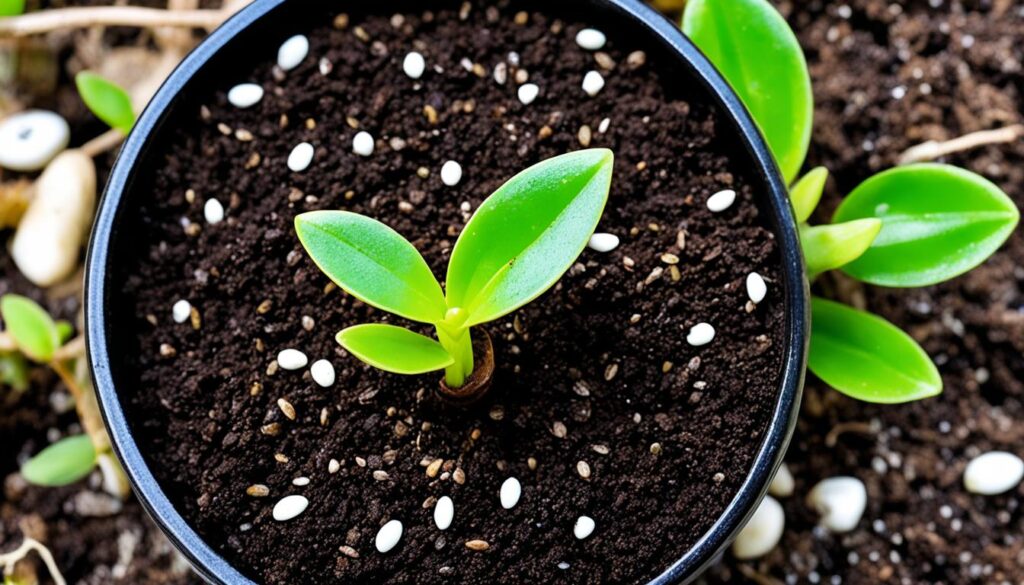
Fertilization: Nourishing Your Orchid
During the growing season, a balanced liquid fertilizer supports healthy growth.
As the plant enters its flowering phase, switching to a fertilizer with a higher potassium content helps promote more vibrant blooms.
However, during the orchid’s rest period, I recommend reducing the frequency of fertilization to coincide with its natural cycle.
| Care Aspect | Details |
|---|---|
| Lighting | Bright, indirect light |
| Watering | Even moisture, allowing the top third to dry between watering |
| Humidity | Average room humidity, pebble trays can help increase moisture levels |
| Fertilization | Balanced during growth, high potassium for flowering, reduced during dormancy |
Special Care Instructions
As I delve deeper into the world of indoor gardening and share my experiences with jewel orchid propagation and seasonal plant care, I’ve gathered some exclusive tips for cultivating these enchanting plants.
Jewel Orchids, with their resplendent leaves, require nuanced attention, especially as the seasons change.
Here, I’ll walk you through the crucial steps to ensure your precious orchids receive the tailored care they need.
Dormancy Care & Annual Flowers
Maintaining the enigmatic beauty of the Jewel Orchid involves understanding its dormancy cycle. I’ve found that by slightly stressing my orchids through pot-binding and reducing watering, they’re more likely to produce their charming flowers.
The magic trick here is simple: cooler temperatures and lower light levels, mimicking their natural habitat’s conditions, can coax them into dormancy, which often results in delightful blooms.
Offering a tomato feed enriched in potassium during this phase has served as a nutritious supplement, fostering robust growth when the growing season returns.
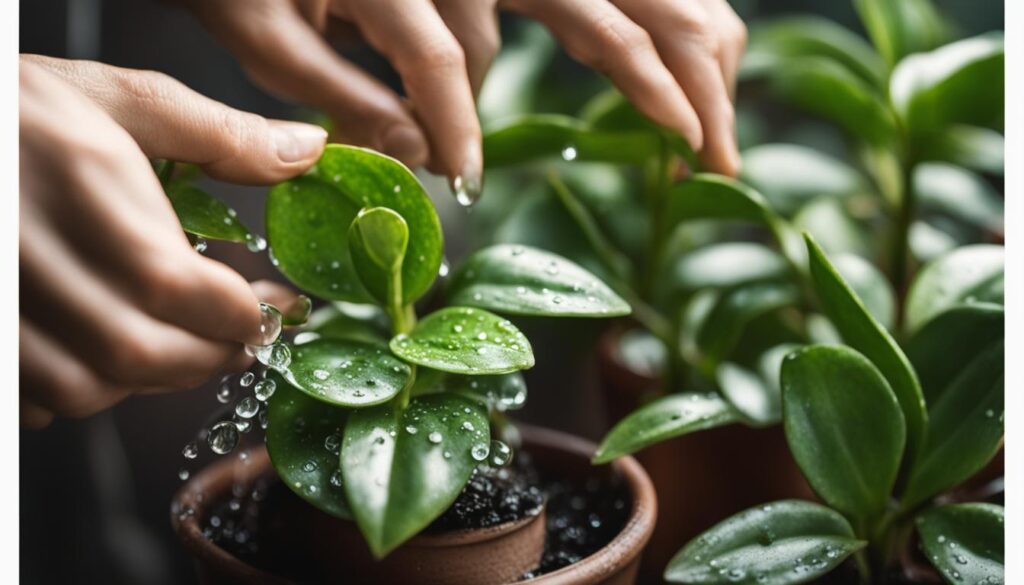
Common Issues and Solutions
The glow of a lush Jewel Orchid can be dimmed by common problems like yellowing leaves and unwanted leaf loss.
Balancing the delicate act of watering to ensure the roots are moist, but not drenched, remains key in maintaining plant vigor.
Monitoring the humidity to prevent the spread of mildew is equally important, as is securing good air circulation.
It’s the subtleties of indoor gardening care tips that make all the difference.
Pests & Diseases: Prevention and Treatment
Did you know that pests like Mealybugs can see your Jewel Orchid as the perfect home?
Vigilance and early intervention are crucial, I make it a point to regularly inspect my plants for any signs of insect visitors and respond promptly with appropriate treatments.
Prevention is always better than cure, so maintaining a clean environment and using natural pest deterrents helps keep these invaders at bay.
Pruning & Maintenance
To keep your indoor greenery looking pristine, regular pruning is a must. Jewel Orchids benefit from a trim now and then to remove dead leaves and promote airflow.
This routine maintenance ensures a tidier appearance and, more importantly, a healthier plant.
ollow these care tips for Jewel Orchid to foster a vibrant and thriving addition to your indoor garden landscape.
Propagation: Expanding Your Collection
Gardening enthusiasts often look forward to the joy of expanding their indoor garden, and jewel orchid propagation stands out as an especially rewarding pastime.
In my experience, the process of propagating these beautiful plants allows for the cultivation of rare jewel orchid varieties, enhancing the diversity and allure of my plant collection.
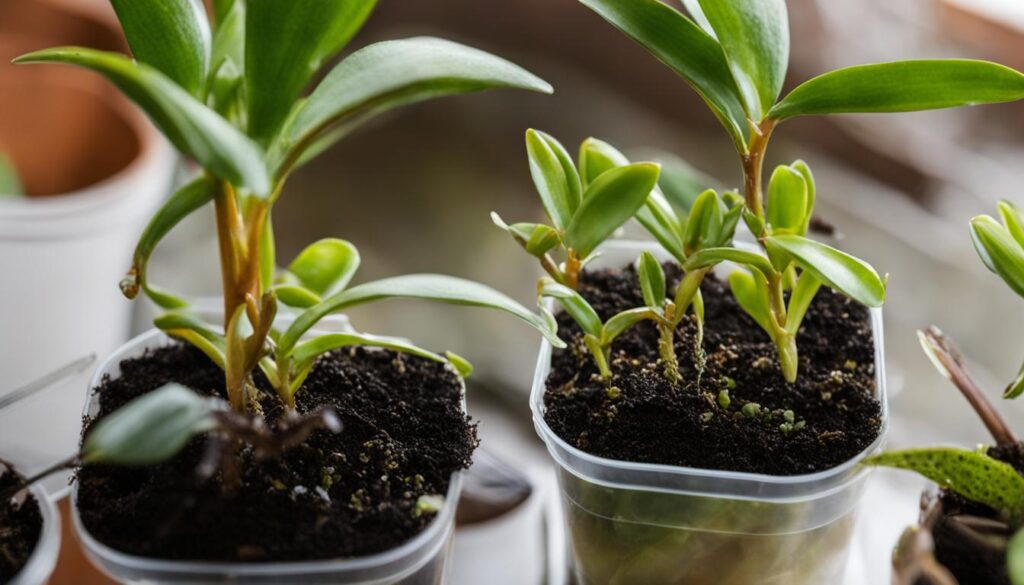
Propagation techniques for jewel orchids, primarily through division and stem cuttings, open up an accessible path to multiplying these exceptional plants.
Being sympodial, jewel orchids extend laterally rather than vertically, which works in favor of their reproduction through these methods.
Methods of Propagating Jewel Orchids
When repotting, I often find that division is the simplest method of propagation for these orchids. By gently separating the plant at the root level, new, independent plants can be created.
Stem cuttings also prove to be an effective technique. I carefully select a healthy stem with several leaves, cut it off, and place the cutting in a similar potting mix as the parent plant.
It requires patience and careful handling, given the fragile nature of the stems, but within a couple of months, I’m rewarded with the sight of new roots and, eventually, new growth.
This not only leads to a more extensive collection but also to the conservation of some of the rare jewel orchid varieties that might be hard to find elsewhere.
Whether you’re a seasoned indoor gardener or just beginning to dabble in the world of orchids, understanding and applying these propagation techniques will surely enrich both your garden and your gardening experience.
Repotting: When and How
As an avid indoor gardener, I consider the health and vigor of my plants paramount, particularly when it comes to container gardening and the flourishing of my jewel orchids.
Recognizing the signs that my orchids need repotting and understanding the process is integral to providing optimal indoor orchid care.
Choosing the Right Soil & Container
Securing the best soil for jewel orchid growth involves a specific blend that ensures both moisture retention and proper aeration.
A popular choice is a mix of peat moss and perlite, which offers the ideal balance. Alternatively, a combination of bark, sphagnum moss, and perlite can also create a hospitable environment for these terrestrial beauties.
The right container should accommodate the orchid’s growth pattern, which is wide and shallow, rather than tall and narrow.
| Component | Benefits | Considerations |
|---|---|---|
| Peat Moss | Excellent moisture retention | Can compact over time, so requires regular refreshing |
| Perlite | Increases aeration | Should be used sparingly to not dry out the soil too much |
| Bark | Mimics natural orchid habitat | Decomposes over time, meaning more frequent changes may be necessary |
| Sphagnum Moss | Retains moisture and nutrients | Needs to be fluffed regularly to prevent compaction |
I’m always cautious about repotting plants, especially the jewel orchid, which should occur typically once every three years or when the plant becomes overcrowded in its pot.
This usually takes place in the spring, which allows the plant to recover and grow throughout the coming season.
During repotting, I meticulously assess the root system to remove any dead or rotting parts, ensuring the continued health of the orchid.
The addition of a new pot and fresh soil feels like a new beginning in my indoor orchid care journey.
I find it deeply rewarding to provide my plants with the best possible environment to thrive in, which includes offering them the nutrients and care they require.
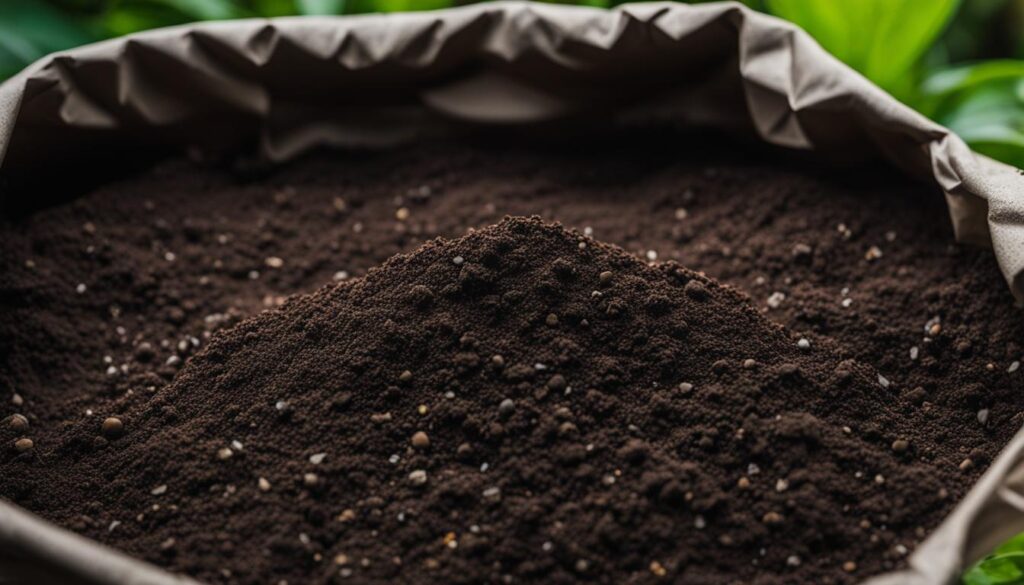
The Jewel Orchid’s Lifecycle
Embarking on the journey of nurturing a rare jewel orchid is to embrace the ebbs and flows of its captivating lifecycle.
These terrestrial wonders, renowned for their understated blooms and beguiling foliage, move through the seasons with a rhythm that seasoned gardeners come to know intuitively.
When it comes to jewel orchid care, insight into its seasonal needs ensures the plant’s vitality and splendor.
Here, we delve into the nuances of the blooming cycles and growth phases that characterize the life of these enchanting plants.
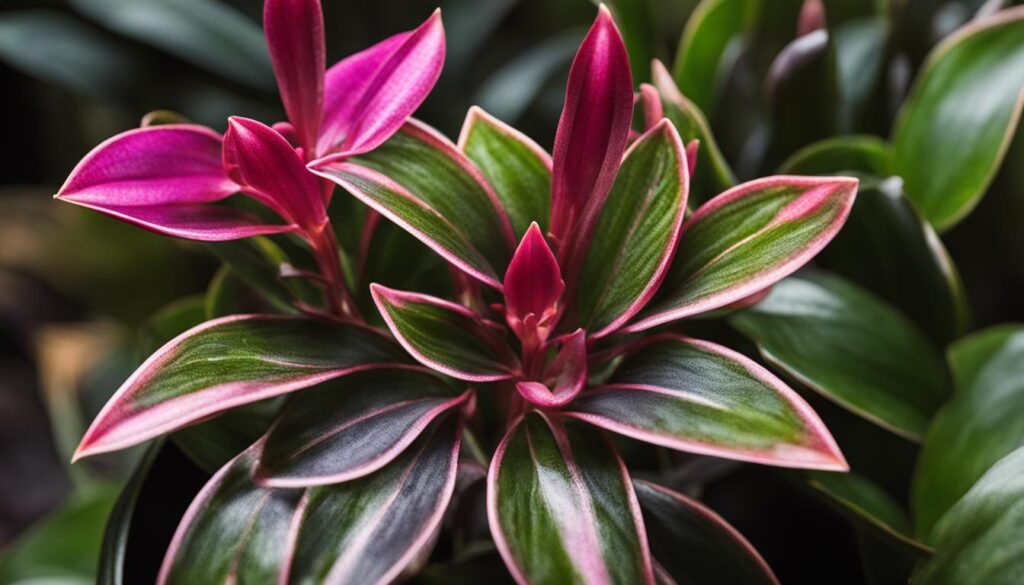
Blooming: Encouraging Flowers
The floral showcase of a jewel orchid, although not its primary allure, adds a subtle grace to its appearance throughout the winter months.
As enthusiasts of seasonal plant care, we’ve learned that mimicking the orchid’s natural environment primes it for these displays of delicate beauty.
Here’s a snapshot of the conditions conducive to flowering:
- Limited sunlight exposure, with a preference for bright, indirect light that illuminates without scorching its leaves.
- Temperatures that dip slightly, simulating the cooler underbrush of its indigenous habitat, provoke the blooming impulse.
- Maintaining hydration carefully, to ensure the orchid’s roots are neither parched nor drenched.
- Feeding strategy adapted to encourage blooms, typically reduced yet enriched with bloom boosters.
Understanding Growth Phases
Just as a seasoned gardener is attuned to the shifting seasons, so too must they be to the growth phases of their treasured jewel orchids.
Vigilance and iterative adjustments in care play pivotal roles in the plant’s health and longevity.
Akin to a dance, the gardener and orchid move in sync, responding to one another’s cues, a pas de deux of growth and adaptation. To illustrate this, let’s outline the phases:
| Growth Phase | Signs | Required Care |
|---|---|---|
| Initiation | New shoots emerging from the base | Increased water and fertilization to support growth |
| Development | Leaf expansion and root strengthening | Consistent moisture and observation for pests or diseases |
| Maturation | Plant reaches full leaf size; stabilization | Reduced feeding; maintenance of environmental conditions |
| Bloom Preparation | Bud formation indicates forthcoming flowers | Lower temperatures and controlled watering to induce blooming |
By cultivating a deep-seated knowledge and responsive care routine, we can experience the joy of witnessing our rare jewel orchid flourish through its elegant lifecycle, an enchanting reward for our dedication to jewel orchid care.
Addressing Common Concerns
When cultivating the luminous beauty of jewel orchids, gardeners may face the all-too-common quandaries associated with these enchanting plants.
As a gardener dedicated to the flourishing of my orchids, I’ve learned to navigate challenges like overwatering, leaf discoloration, and persistent pests.
Sharing these insights is not merely about problem-solving; it’s about enhancing our collective knowledge of jewel orchid care so that these ornamental plants can continue to captivate and charm within our indoor gardens.
Overwatering and Root Rot
Too much water can become the bane of a jewel orchid’s existence. I’ve observed that the delicate balance between hydration and over-saturation is critical, where my zeal to water generously has led, regrettably, to instances of root rot.
It’s a dance of restraint and timing, allowing the soil to approach dryness before the next watering, effectively preserving the roots’ vitality.
Leaf Discoloration and Damage
Indeed, not all that glitters is healthy. Sometimes, the shimmering leaves may betray signs of distress through discoloration.
I’ve addressed such leaf discoloration by adjusting water and light, these being the typical culprits undermining the orchid’s well-being.
Diminishing direct sunlight and ensuring a consistent watering schedule can reinstate the rich, vibrant hues indicative of a thriving plant.
Dealing with Pests and Diseases
Protecting these terrestrial gems requires eternal vigilance, especially in pest management. Mealybugs, those tiny harbingers of destruction, are the adversaries I encounter most.
Through regular inspection and intervention, may it be with neem oil or insecticidal soap, their insidious march is halted, preserving the integrity of my jewel orchids.
| Issue | Signs | Preventive Measures | Treatment |
|---|---|---|---|
| Overwatering | Root rot, limp foliage | Water when the top third of soil is dry | Reduce watering, improve drainage |
| Leaf Discoloration | Yellowing or browning tips | Proper light and consistent moisture levels | Adjust lighting, verify watering routine |
| Pests | Visible insects, sticky leaves | Regular inspection, maintain cleanliness | Application of neem oil or insecticidal soap |
It’s essential, in my experience, to foster an environment that anticipates and precludes these concerns from taking root.
By employing the right balance of care and attention, my jewel orchids continue to grace my home with their extraordinary allure.
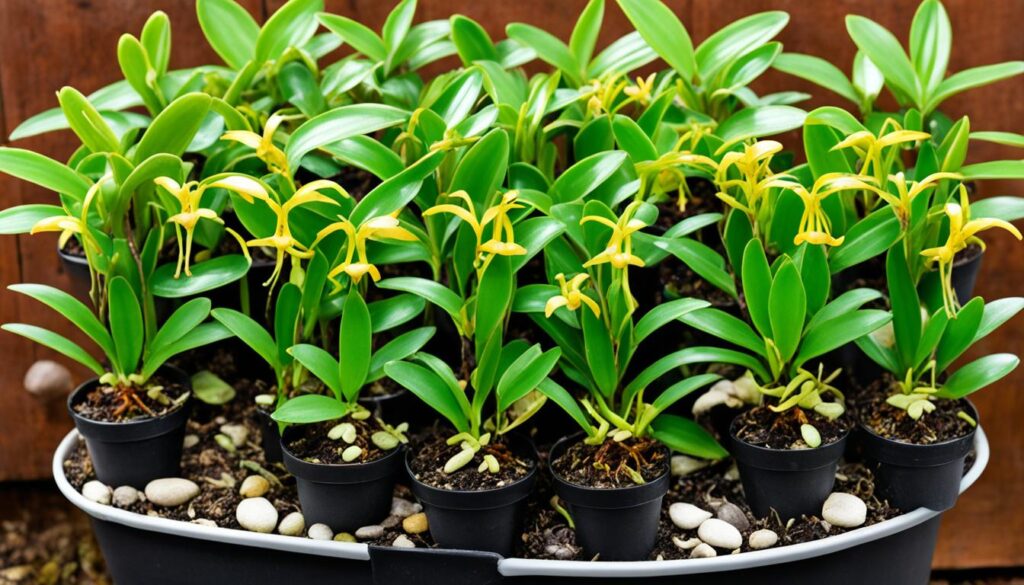
Ensuring Year-Round Care
Indoor gardening involves adapting to the seasonal rhythms of your plants, especially when tending to the unique needs of jewel orchid varieties.
As we approach the colder months, delivering precise winter plant care tips will aid in sustaining the lush beauty of your indoor botanical oasis.
Winter Care for Jewel Orchids
During the winter, our leafy companions undergo subtle yet significant changes. The slower pace of growth and the potential for flowering make it a time for attentive seasonal plant care.
The key to aiding your jewel orchids during these dormant months lies in replicating their natural environment. This includes scaling back on irrigation, as excessive water can lead to root issues due to a decrease in transpiration.
Maintaining a slightly cooler room temperature can also signal to your plant that it’s time to conserve energy for the upcoming spring.
To prevent dry air from stressing your orchids, which can be common with indoor heating systems, consider setting up a pebble tray filled with water to enhance humidity levels around your plants.
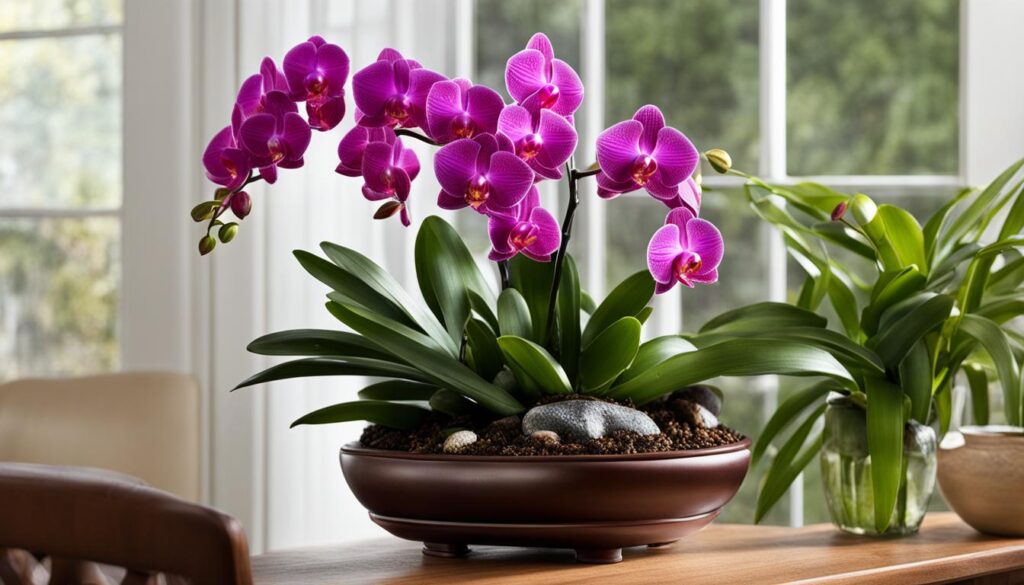
Adjusting Care for Seasonal Changes
As the seasons progress and your jewel orchids transition from resting to active growth, adjusting their care is paramount.
With the advent of spring, it is appropriate to moderately increase watering and reintroduce fertilization. This encourages the plant to invest energy into new shoots and leaves.
As your orchid awakens, it is also an opportunity to assess and address any requirements for repotting or propagation, laying the groundwork for robust growth through the remainder of the year.
- Monitor light exposure as days lengthen and reposition plants if necessary to avoid leaf burn.
- Gradually increase irrigation as growth resumes, tailoring your approach to your orchid’s response.
- Replenish nutrients with a balanced, orchid-specific fertilizer to support flowering and foliage development.
By attuning to the unique seasonal needs of your indoor jewel orchid varieties, you nurture not only their vibrance and health but also the year-round splendor they bring to your living space.
The Beauty of Jewel Orchids
Within the realm of indoor gardening, I’ve found that certain plants stand out for their extraordinary visual appeal, and among these, the Jewel Orchids have certainly carved out a considerable niche.
It’s their sublime foliage, and lush, delicately patterned leaves, that capture the eyes of enthusiasts.
These rare jewel orchids are particularly valued for their distinct aesthetic, and my personal experience with Ludisia discolor has been noteworthy.
Taking care of these non-toxic houseplants has been both a joy and a journey of learning, as their maintenance fits seamlessly into a household with pets and children.
Toxicity: Safety for Pets and Children
What brought me closer to Jewel Orchids was their safety, which cannot be overstated. Discovering that these ornamentals are non-toxic transformed my perception of indoor orchid care, broadening its scope in safe home environments.
As a guardian of both flora and fauna within my living space, ensuring that my botanical choices pose no threat to curious pets or children is paramount. Thus, these plants make an ideal choice for adding greenery without worry.
The Unique Appeal of Ludisia Discolor
The specific allure of Ludisia discolor lies in its subtle yet sophisticated appearance. These orchids exhibit a lustrous presence that speaks volumes about their rare jewel orchid status, with velvety leaves decorated with a tapestry of pinstripe patterns.
Ensuring optimal lighting conditions and attentive indoor orchid care has allowed the aesthetics of my Ludisia discolor to flourish, making it a centerpiece in my collection.
The remarkable appearance of this orchid variety offers an endless source of delight and a testament to the enduring beauty indoor plants can provide.
FAQ
How should I approach indoor gardening with a Jewel Orchid?
When bringing a Jewel Orchid like Ludisia discolor into your indoor gardening collection, consider it a unique plant that thrives in conditions different from typical houseplants. Focus on creating a tropical environment with bright, indirect light, consistent moisture, and high humidity to mimic their natural forest floor habitat. Regular plant care tips include providing the right orchid potting media and ensuring seasonal changes in care to adapt to their growth cycles.
What are the basic care requirements for Ludisia discolor?
Jewel Orchids require care routines that include moderate lighting (bright, indirect light), consistent moisture without waterlogging, regular fertilization during the growth period, and increased humidity. They should be grown in a potting mix that retains moisture yet offers good drainage. Annual repotting can be beneficial, along with periodic pruning to maintain their attractive appearance.
Where do Jewel Orchids originate from, and how does this affect their care?
Jewel Orchids originate from the tropical regions of Southeast Asia to eastern North America. They are accustomed to the dappled light and high humidity of forest floors. When caring for these plants, try to replicate these conditions through your choice of location, potting mix, and humidity levels for optimal growth.
What are the specific lighting requirements for a Jewel Orchid?
Jewel Orchids should be placed in an area with bright but indirect light. Direct sunlight should be avoided as it can scorch their leaves. A common rule of thumb for adequate lighting is if you can read a newspaper comfortably in the light without your shadow falling over it, then it’s generally good for your Jewel Orchid.
How do I properly water my Jewel Orchid?
Watering your Jewel Orchid should be done in a way that keeps the soil consistently moist, but not waterlogged. Let the top third of the soil dry out between waterings. This prevents root rot and simulates the moist environment they experience in their native habitat.
How can I create a suitable tropical oasis for my Jewel Orchid at home?
Simulate tropical conditions by maintaining high humidity around your Jewel Orchid. This can be achieved by placing the orchid on a pebble tray filled with water or using a humidifier, especially during the drier months. Remember, adequate air circulation is important to prevent mold and mildew.
What type of fertilizer is best for Jewel Orchids and how should I apply it?
Fertilize Jewel Orchids with a balanced, water-soluble fertilizer diluted to half-strength, or one specifically formulated for orchids, following the instructions on the label. During the growth period, fertilize regularly, but reduce frequency during dormancy.
How do I care for my Jewel Orchid during its dormancy period?
During the dormancy period, usually in the cooler months, cut back on watering, allowing the orchid to experience a drier rest period. This can encourage blooming when the growing season returns. Keep the plant in a cooler room with less artificial light during dormancy.
What are the common issues faced by Jewel Orchid owners, and how can these be resolved?
Common issues include yellowing leaves, leaf drop, and root rot, often due to overwatering or poor lighting. Adjust watering habits, ensure good light, and consider repotting in fresh orchid potting mix if needed. Also, watch for pests such as mealybugs, and treat promptly with appropriate pest management methods.
How can I prevent and treat pests and diseases in Jewel Orchids?
Prevent pests and diseases by keeping the leaves clean and the area around the orchid free from debris. Provide good air circulation and avoid overwatering. Treat infestations of pests like mealybugs with insecticidal soap or neem oil, and address diseases by removing affected areas and improving the plant care environment.
When and how should I prune and maintain my Jewel Orchid?
Prune your Jewel Orchid to remove dead or yellowed leaves and to shape the plant for a more aesthetically pleasing appearance. Use sterilized pruning tools to prevent disease spread. Maintenance should also include regular inspection for pests and diseases to keep the plant healthy.
What are effective methods for propagating Jewel Orchids?
Propagate Jewel Orchids by division or stem cuttings. For division, separate the rhizomes during repotting. Stem cuttings can be taken and placed in moist potting media, keeping them warm and humid until they root. This can be a great way to expand your indoor garden collection or share with other plant enthusiasts.
How do I choose the best soil and container for repotting my Jewel Orchid?
Choose orchid potting media that retains moisture but allows for drainage, such as a mix of peat moss, bark, and perlite. Select a wide, shallow pot that accommodates the orchid’s terrestrial habit and allows for slight overcrowding, which Jewel Orchids often prefer.
How can I encourage my Jewel Orchid to bloom?
To encourage blooming in Jewel Orchids, ensure that they receive ample indirect light, consistent moisture, and correct fertilization with a high-potassium feed. Also, allow them to go through a rest period with cooler temperatures and less watering to stimulate flower production.
How do I understand and manage the various growth phases of my Jewel Orchid?
Monitor your Jewel Orchid’s lifecycle by observing its growth patterns. During active growth periods in spring and summer, increase watering and fertilization. During dormant periods in fall and winter, reduce these care practices. This mimics the seasonal cycles they experience in nature and optimizes plant health.
What should I do to avoid overwatering and prevent root rot in my Jewel Orchid?
To avoid overwatering, let the top third of the soil dry out before watering again, and ensure the pot has good drainage. If root rot is suspected, carefully remove the plant from its pot, trim away any rotten roots, and repot into fresh, sterile potting media.
How do I address leaf discoloration and damage on my Jewel Orchid?
Leaf discoloration can be a sign of too much direct sunlight or inconsistent watering. Relocate your orchid to a place with indirect light and adjust your watering routine to ensure even soil moisture. If damage occurs from pests, treat with an appropriate pesticide and improve care conditions to prevent future issues.
How do I adjust care for my Jewel Orchid with seasonal changes?
As seasons change, so should the care for your Jewel Orchid. Reduce watering and fertilization in the winter to simulate a dormant period, and increase both as temperatures rise and growth resumes in the spring. Always adjust light exposure as well to mimic natural seasonal changes in the wild.
Are Jewel Orchids safe for pets and children?
Yes, Jewel Orchids, including Ludisia discolor, are non-toxic and safe for homes with pets and kids. You can enjoy the beauty and unique appeal of these plants without worrying about their safety impact on your loved ones.
What sets Ludisia discolor apart from other indoor plants?
The Ludisia discolor or Jewel Orchid is exceptional due to its lustrous, velvety leaves with beautiful pinstripe patterns, making it a visually striking addition to an indoor plant collection. Unlike other orchids, it is prized for its foliage and not just its flowers, showcasing a different aspect of orchid beauty.


Leave a Reply